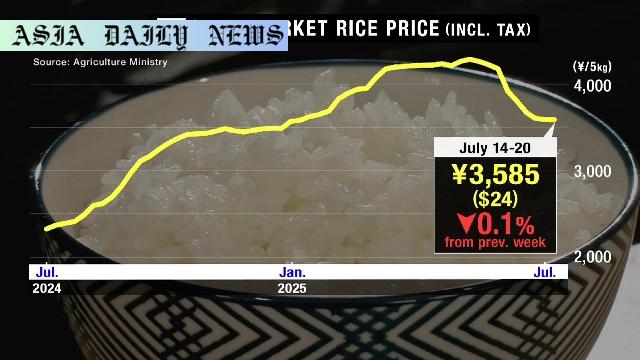Rice prices decline as consumers diversify between stockpiled and brand-name varieties.

Introduction: A Decline in Japan’s Rice Prices
Rice, a staple food in Japan and a critical component of the nation’s culinary culture, has recently experienced a continuous drop in prices. For nine consecutive weeks, supermarket rice prices in Japan have declined, much to the relief of budget-conscious consumers. The country’s agriculture ministry has released data showcasing this trend, marking a significant shift within the domestic rice market. The average price of a 5-kilogram bag of rice now stands at 3,585 yen (approximately $24), which represents a modest one-tenth of a percent decrease from the previous week’s price. While this may seem like a small decline, the trend itself is noteworthy, especially given the sharp fluctuations that marked the market last year.
Government Intervention: Tapping into National Reserves
Last year, rice prices nearly doubled in the span of twelve months, prompting governmental action to stabilize costs. In response, officials began utilizing national reserves of rice, which led to an initial sharp decline in prices. This measure not only aimed to ensure affordability for consumers but also to protect the broader economy from further inflationary pressures. However, as this decline has begun to slow in recent weeks, it raises questions about how effective these interventions can remain in the long term.
Consumer Preferences: Brand-Name vs. Government Stockpiles
The choices consumers make are also contributing to the dynamics of rice pricing in Japan. According to Orikasa Shunsuke, Principal Researcher at the Distribution Economics Institute of Japan, there has been a noticeable divergence in consumer behavior. Budget-conscious shoppers are opting for government-stockpiled rice, while others are choosing brand-name varieties that may carry a higher price. This duality in consumer preference has slowed the overall pace of the price decline, despite the continued availability of cheaper alternatives.
The Role of Weather: A Potential Supply Disruption
While the current decrease in prices is a relief for many, the future supply of rice in Japan may face challenges due to weather conditions. Orikasa also notes the impact of unusually hot weather during the recent rainy season, which was accompanied by a lack of sufficient rainfall. These conditions could potentially harm this year’s rice harvest, reducing overall supply and potentially reversing the downward trend in prices. Addressing these environmental challenges will be crucial for ensuring stability in Japan’s rice market moving forward.
Conclusion: Implications for the Economy and Consumers
In summary, the ongoing decline in rice prices in Japan sheds light on the interconnected factors of government policy, consumer behavior, and environmental challenges. While the decrease in prices offers immediate relief, particularly for those grappling with the rising cost of living, the potential for supply disruptions remains a concern. Policymakers and agricultural stakeholders must continue to monitor these developments closely, ensuring that Japan’s key staple remains affordable and accessible to all.
Commentary
Introduction: Observing Japan’s Rice Price Dynamics
The recent decline in rice prices in Japan has significant implications for both consumers and the broader economy. Rice is not just a staple food but also a cultural cornerstone, and any fluctuation in its pricing inevitably draws widespread attention. For nine consecutive weeks, prices have seen a steady decline, signaling some relief for households struggling with rising living costs. However, the factors driving this trend and its potential long-term consequences merit closer examination.
Government Intervention and Market Trends
The Japanese government’s decision to release national reserves of rice has been instrumental in stabilizing the market. This intervention, aimed at curbing the dramatic price surge observed last year, underscores the critical role that policy can play in addressing economic challenges. However, as the rate of price decline slows, it raises questions about the sustainability of this approach. Is tapping into reserves a short-term solution to a deeper structural issue in Japan’s agricultural economy?
Consumer Choices and Market Segmentation
What stands out in this situation is the changing behavior of Japanese consumers. The divergent preferences—between those opting for affordable, government-stockpiled rice and those sticking with brand-name varieties—highlight the complexities of consumer decision-making. While affordability remains a priority for many, the willingness of some to pay more for specific brands suggests that quality and personal taste continue to influence purchasing decisions. This duality may help stabilize the market but could also slow down any significant price adjustments.
Future Challenges: Weather and Supply Dynamics
The impact of unpredictable weather patterns adds an additional layer of uncertainty. The unusually hot rainy season and lack of rainfall have raised concerns about this year’s rice harvest. If harvest yields drop, the delicate balance achieved through government intervention and consumer preferences could be disrupted, potentially leading to new price hikes. Policymakers and agricultural experts must focus on mitigating these risks to ensure long-term stability in the rice market.
Conclusion: A Complex but Manageable Situation
In conclusion, while the current drop in rice prices provides a temporary reprieve for Japanese households, the situation remains complex and multifaceted. The interplay between government intervention, consumer behavior, and environmental factors will determine the future trajectory of rice prices in Japan. Continuous monitoring and proactive strategies will be essential to navigate this intricate landscape effectively.


